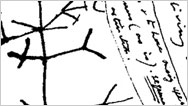Evolution in Action: Salamanders
- Posted 11.01.07
- NOVA
NOVA visits David Wake, a renowned evolutionary biologist at the University of California, Berkeley, as he explains why members of the same species of California salamander look and behave so differently. It's a case study of Darwin's theory of evolution by natural selection, and an example, Wake says, that Darwin himself would have loved.
Transcript
Evolution in Action: Salamanders
Posted: November, 1 2007
NARRATOR: Meet a type of terrestrial salamander found in California. Now meet another. And another. These salamanders are members of the same species, so why do they look and behave so differently? In California, populations of these salamanders became separated geographically, evolving over millions of years to adapt to different environments. They've changed so much that they are on their way to becoming entirely separate species. David Wake of the University of California, Berkeley explains.
DAVID WAKE (University of California, Berkeley): The history of this species complex began about 10 million years ago in the ancient redwood forests in Northern California where we have today this form picta which is highly variable both genetically and in terms of coloration. There were two migratory routes followed by animals as they moved into Southern California: one along the Sierra Nevada mountain chain where animals moved into the forest region, the other along the coastal mountains. They avoided the Great Central Valley.
NARRATOR: The populations that gradually moved down the forested region of California relied on blending in with their environment. Animals with good camouflage tended to survive more and produce offspring with similar traits. As the salamanders progressed south over millions of years, the markings became more distinct.
DAVID WAKE: At the end of the chain in Southern California we have this E. klauberi which is the extreme of variation, showing the largest blotches, most gold marking. These were all then camouflaged organisms that were hiding from predators.
Along the coast a different strategy was followed. Here the organisms adopted the color pattern and behavior of dangerously poisonous newts, and they became, instead of camouflaged, they were advertising their resemblance to these dangerously poisonous animals and gaining an advantage because of their mimicry. So what happened is that you had two differently adapted lineages moving to the south, and by the time they reached the southern end, they had essentially evolved into different species, but, at certain areas, for example in the Palomar Mountain area of San Diego County, we get these animals which are hybrids, and the hybrids are neither similar to the dangerously poisonous animals, they're not good mimics, nor are they good animals in terms of camouflage, so these organisms are essentially dead ends.NARRATOR: These hybrid offspring are not well adapted to their environment and are therefore less likely to survive. The two parent subspecies that produced the hybrids are well on their way to becoming entirely separate species, evolving just as Darwin described in his theory of evolution.
DAVID WAKE: I think Darwin would love this example because it shows exactly the sorts of patterns that he was talking about. Gradual adaptive divergence, leading eventually to the establishment of new species.
Credits
Video podcast produced by Melissa Salpietra and Susan K. Lewis. Edited and narrated by Melissa Salpietra. Original footage produced by Joe McMaster. "Judgment Day: Intelligent Design on Trial" is produced by NOVA and Vulcan Productions, in association with The Big Table Film Company.
Participants
- David Wake
- University of California, Berkeley ib.berkeley.edu/labs/wake/wakelab.htm
Related Links
-

Arms Race With a Superbug
Certain microbes evolve defenses against every antibiotic we throw at them. Staph aureus is a sobering case in point.
-

Evolution in Action
In this game, change the environment of "living" things and see how random mutations help them survive.
-

Darwin's Predictions
Over 150 years later, science continues to confirm most of Darwin's conjectures.

